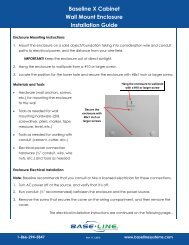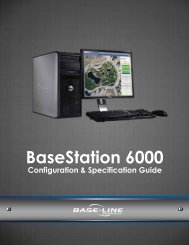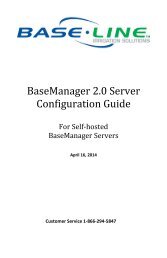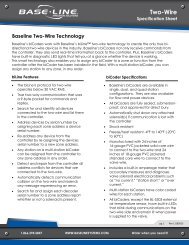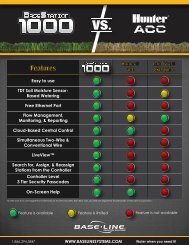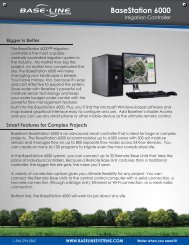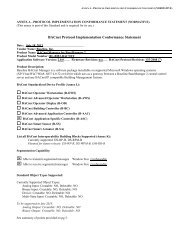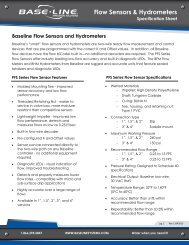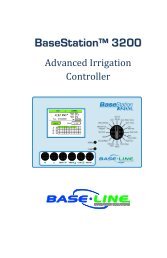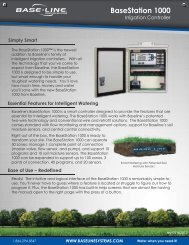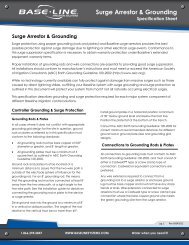BaseStation 3200 User Manual â 11.7.5.15 ... - Baseline Systems
BaseStation 3200 User Manual â 11.7.5.15 ... - Baseline Systems
BaseStation 3200 User Manual â 11.7.5.15 ... - Baseline Systems
You also want an ePaper? Increase the reach of your titles
YUMPU automatically turns print PDFs into web optimized ePapers that Google loves.
<strong>BaseStation</strong> <strong>3200</strong> Advanced Irrigation Controller <strong>Manual</strong><br />
primary zone<br />
program<br />
pump start<br />
runoff<br />
saturation<br />
scheduling group<br />
soak cycle<br />
soil-moisture<br />
content<br />
soil-moisture<br />
deficit<br />
time domain<br />
transmission (TDT)<br />
timed zone<br />
transpiration<br />
two-wire<br />
upper limit<br />
valve<br />
The zone within a scheduling group that all other linked zones are linked to. Changing the<br />
programming on this zone will adjust the programming on all linked zones, resulting in<br />
saved time and consistency. If you are using a biSensor, the primary zone is the zone that<br />
the sensor is connected to.<br />
A program is a controller programming concept used to organize watering events. Each<br />
program can have different schedules, water days, watering strategies, master valves, etc.<br />
The <strong>BaseStation</strong> <strong>3200</strong> supports up to 20 programs.<br />
A relay or relay-type device that initiates turn on of a pump, typically a high horsepower<br />
electrical or motor driven pump.<br />
When the soil moisture content is at the saturation level, any excess water from rain,<br />
snow melt, or irrigation drains to a low point in the landscape<br />
When the soil moisture content is at this level, nearly all of the spaces between soil<br />
particles are filled with water. After a soil has reached saturation, it does not become<br />
more saturated; although, in some situations where water is trapped, it can become<br />
flooded.<br />
A group of one or more zones that have been linked together for irrigation scheduling. A<br />
scheduling group must have one primary zone, and may have one or more linked zones.<br />
Irrigation for all zones in a scheduling group will follow the watering strategy of the<br />
primary zone, but actual irrigation run times and soak/cycle behavior will scale as<br />
programmed relative to the primary zone.<br />
When a zone waters using a soak cycle, the total watering run time includes periods of<br />
watering (run times) interspersed with periods of non-watering times (soak times).<br />
The ratio of the volume of contained water in a soil compared with the entire soil volume<br />
When soil dries (for example, by evaporation), the measurable shortage of water in the<br />
soil is known as the soil-moisture deficit. It also refers to the amount of water needed to<br />
return to field-capacity moisture content.<br />
A measurement of how much the electrical signals in the soil are slowed down by the<br />
presence of water<br />
Any zone programmed to water on a time/day schedule, not a smart irrigation schedule<br />
The loss of water vapor from parts of plants. Water is lost primarily from the pores on the<br />
leaves but also from stems, flowers, and roots<br />
This site wiring technique consists of a cable with an outer insulation, around two internal<br />
insulated wires, being used to provide communication and power for all valves and other<br />
devices throughout the site. It provides full two-way communication much like a<br />
computer network.<br />
This water strategy is programmed by setting the schedule to water with Historical ET<br />
Calendar day intervals, or alternatively with specific days of the week, and then setting<br />
the biSensor to adjust the water run time to “fill up” the moisture to the upper limit (field<br />
capacity). The controller will water a program at each start time and will modify the run<br />
time based on the moisture depletion level.<br />
A device that opens to allow water to flow to the sprinkler heads or emitters in a zone. It<br />
closes to halt watering for that zone.<br />
Page 93



